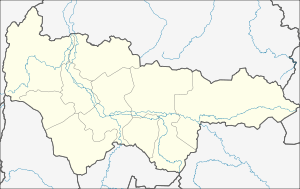Pyt-Yakh
| Pyt-Yakh (English) Пыть-Ях (Russian) | |
|---|---|
| - Town[1] - | |
|
| |
.svg.png) Location of Khanty-Mansi Autonomous Okrug in Russia | |
 Pyt-Yakh | |
|
| |
.png) | |
|
| |
| Administrative status (as of December 2009) | |
| Country | Russia |
| Federal subject | Khanty–Mansi Autonomous Okrug[1] |
| Administratively subordinated to | town of okrug significance of Pyt-Yakh[1] |
| Administrative center of | town of okrug significance of Pyt-Yakh[1] |
| Municipal status (as of December 2009) | |
| Urban okrug | Pyt-Yakh Urban Okrug[2] |
| Administrative center of | Pyt-Yakh Urban Okrug[2] |
| Statistics | |
| Population (2010 Census) | 41,488 inhabitants[3] |
| Time zone | YEKT (UTC+05:00)[4] |
| Founded | 1990 |
| Dialing code(s) | +7 3432 |
|
| |
| Pyt-Yakh on Wikimedia Commons | |
Pyt-Yakh (Russian: Пыть-Ях) is a town in Khanty–Mansi Autonomous Okrug, Russia, located on the east bank of the Bolshoy Balyk River, southeast of Khanty-Mansiysk. Population: 41,488 (2010 Census);[3] 41,813 (2002 Census);[5] 17,101 (1989 Census).[6]
History
The town was formed by merging the settlements of Mamontovo and Pyt-Yakh in 1990. The name of the town means "place of good people" in the Khanty language.
Administrative and municipal status
Within the framework of administrative divisions, it is incorporated as the town of okrug significance of Pyt-Yakh—an administrative unit with the status equal to that of the districts.[1] As a municipal division, the town of okrug significance of Pyt-Yakh is incorporated as Pyt-Yakh Urban Okrug.[2]
Economy
The town's economy is based on oil and natural gas extraction.
References
Notes
- 1 2 3 4 5 Law #43-oz
- 1 2 3 Law #63-oz
- 1 2 Russian Federal State Statistics Service (2011). "Всероссийская перепись населения 2010 года. Том 1" [2010 All-Russian Population Census, vol. 1]. Всероссийская перепись населения 2010 года (2010 All-Russia Population Census) (in Russian). Federal State Statistics Service. Retrieved June 29, 2012.
- ↑ Правительство Российской Федерации. Федеральный закон №107-ФЗ от 3 июня 2011 г. «Об исчислении времени», в ред. Федерального закона №271-ФЗ от 03 июля 2016 г. «О внесении изменений в Федеральный закон "Об исчислении времени"». Вступил в силу по истечении шестидесяти дней после дня официального опубликования (6 августа 2011 г.). Опубликован: "Российская газета", №120, 6 июня 2011 г. (Government of the Russian Federation. Federal Law #107-FZ of June 31, 2011 On Calculating Time, as amended by the Federal Law #271-FZ of July 03, 2016 On Amending Federal Law "On Calculating Time". Effective as of after sixty days following the day of the official publication.).
- ↑ Russian Federal State Statistics Service (May 21, 2004). "Численность населения России, субъектов Российской Федерации в составе федеральных округов, районов, городских поселений, сельских населённых пунктов – районных центров и сельских населённых пунктов с населением 3 тысячи и более человек" [Population of Russia, Its Federal Districts, Federal Subjects, Districts, Urban Localities, Rural Localities—Administrative Centers, and Rural Localities with Population of Over 3,000] (XLS). Всероссийская перепись населения 2002 года [All-Russia Population Census of 2002] (in Russian). Retrieved August 9, 2014.
- ↑ Demoscope Weekly (1989). "Всесоюзная перепись населения 1989 г. Численность наличного населения союзных и автономных республик, автономных областей и округов, краёв, областей, районов, городских поселений и сёл-райцентров" [All Union Population Census of 1989: Present Population of Union and Autonomous Republics, Autonomous Oblasts and Okrugs, Krais, Oblasts, Districts, Urban Settlements, and Villages Serving as District Administrative Centers]. Всесоюзная перепись населения 1989 года [All-Union Population Census of 1989] (in Russian). Институт демографии Национального исследовательского университета: Высшая школа экономики [Institute of Demography at the National Research University: Higher School of Economics]. Retrieved August 9, 2014.
Sources
- Дума Ханты-Мансийского автономного округа — Югры. Закон №43-оз от 7 июля 2004 г. «Об административно-территориальном устройстве Ханты-Мансийского автономного округа — Югры и порядке его изменения», в ред. Закона №129-оз от 9 декабря 2015 г. «Об изменениях административно-территориального устройства Ханты-Мансийского автономного округа — Югры и о внесении изменений в отдельные Законы Ханты-Мансийского автономного округа — Югры». Вступил в силу по истечении десяти дней со дня официального опубликования. Опубликован: "Новости Югры", №83, 17 июля 2004 г. (Duma of Khanty-Mansi Autonomous Okrug—Yugra. Law #43-oz of July 7, 2004 On the Administrative-Territorial Structure of Khanty-Mansi Autonomous Okrug—Yugra and on the Procedures for Its Change, as amended by the Law #129-oz of December 9, 2015 On the Changes to the Administrative-Territorial Structure of Khanty-Mansi Autonomous Okrug—Yugra and on Amending Various Laws of Khanty-Mansi Autonomous Okrug—Yugra. Effective as of the day which after ten days after the official publication date.).
- Дума Ханты-Мансийского автономного округа — Югры. Закон №63-оз от 25 ноября 2004 г. «О статусе и границах муниципальных образований Ханты-Мансийского автономного округа — Югры», в ред. Закона №129-оз от 9 декабря 2015 г. «Об изменениях административно-территориального устройства Ханты-Мансийского автономного округа — Югры и о внесении изменений в отдельные Законы Ханты-Мансийского автономного округа — Югры». Вступил в силу по истечении десяти дней со дня официального опубликования и до 1 января 2006 года применяется в целях реализации статей 84, 85 Федерального закона от 06.10.2003 №131-ФЗ. Опубликован: "Новости Югры", №143, 7 декабря 2004 г. (Duma of Khanty-Mansi Autonomous Okrug—Yugra. Law #63-oz of November 25, 2004 On the Status and Borders of the Municipal Formations of Khanty-Mansi Autonomous Okrug—Yugra, as amended by the Law #129-oz of December 9, 2015 On the Changes to the Administrative-Territorial Structure of Khanty-Mansi Autonomous Okrug—Yugra and on Amending Various Laws of Khanty-Mansi Autonomous Okrug—Yugra. Effective as of the day which after ten days after the official publication date; also in effect until January 1, 2006 in order to meet the requirements of Articles 84, 85 of the Federal Law #131-FZ of October 6, 2003.).